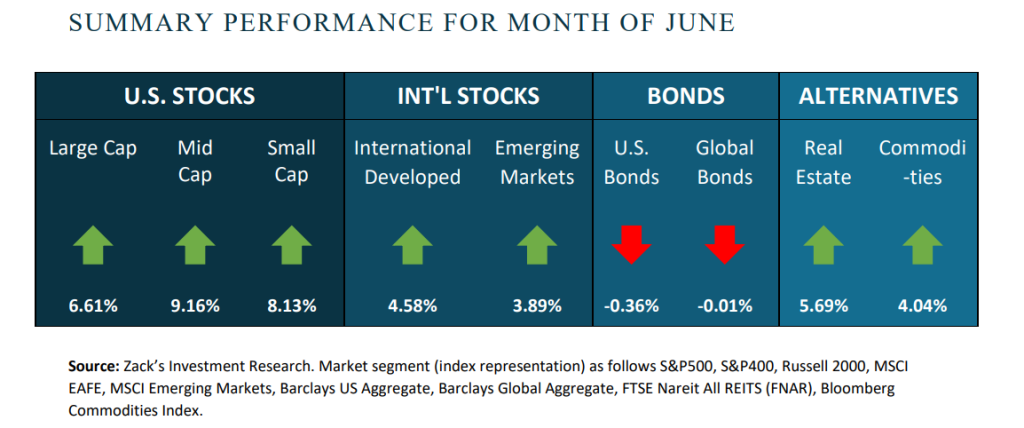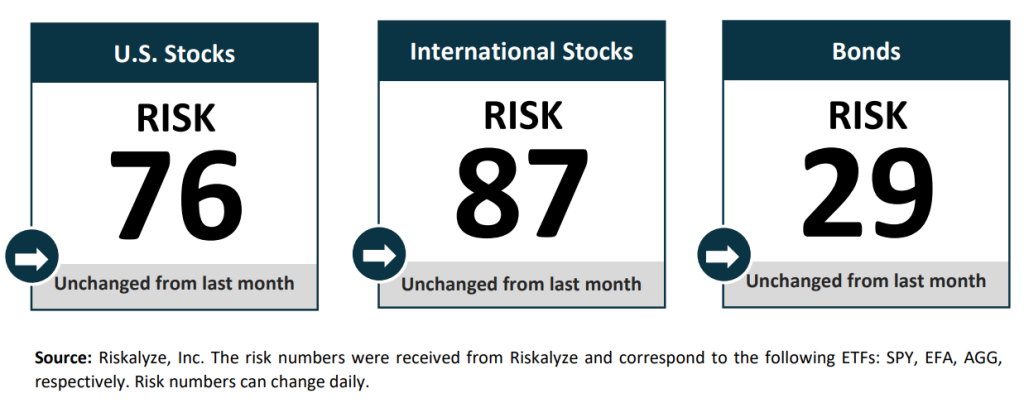by Richard Cull
June Market Recap & Commentary

Commentary
June was a very solid month for investments and helped most indexes finish the second quarter with positive returns. There were a few days of volatility, but June was markedly quiet.
The only real “events” during the month were the employment report and the Federal Reserves latest rate decision. The market cheered both as unemployment remained historically low and the Fed did not raise interest rates after doing so in their previous ten meetings. Most of the other economic data continues to signal a slowing/ softening of consumer confidence, corporate earnings and economic activity.
As so concisely stated by Jason Draho of UBS, since last summer, the consensus expectation has been that the U.S. economy would enter a recession fairly soon, yet that has not happened as the impact of the pandemic continues to cause confusion. “Disentangling the consequences and normalization of extreme pandemic-related dislocations from normal late-cycle behavior has made assessing the economy more difficult.” The result is noisy, low-quality data giving poor signals.
There have been positive developments of late including the much lower risk of a severe credit crunch since the banking failures in March, broad commodity prices have softened and declining goods inflation. The risk of a severe recession therefore appears lower than it was a few months ago. The markets are focusing on this and moving higher.
But with stubbornly high wage growth and core inflation remaining unacceptably high, central banks may be forced to make additional rate hikes. This is a tenuous position in a financially connected world as international economies face challenges including the eurozone has already turned in two consecutive quarters of negative GDP growth (a technical recession), the U.K. dealing with inflation levels above the U.S., China’s post-COVID recovery stalling, and increasing geopolitical occurrences (Wagner Group’s attempted coup, etc). So while a deep recession will hopefully be averted, a short and shallow recession over the next year still seems likely…let’s call it a SOFTISH LANDING.
While many experts, both novice and professional claim otherwise, the actual outcome is unknowable. Our Centric Investment Committee weighed all of this and more through the lens of a FIDUCIARY (one who acts in the best interest of the client) and unanimously renewed our commitment to investing for the long-term which means staying disciplined to our process of focus on investment fundamentals rather than trying to time the next recession.
Risk Numbers
The Risk Number is at the heart of a sophisticated set of tools to precisely measure the appetite and capacity for risk that each client has, and demonstrate their alignment with the portfolios built for them. The following graphic shows the risk of various asset classes as measured on a scale of 1-99 (1 being the most conservative and 99 being the most aggressive) as of the date above.

CENTRIC’S Approach
We start with a Risk Number, a measurable way to pinpoint how much risk you want, need, and already have. Then, your wealth advisor will optimally allocate our investments to help you reach your financial goals. Along the way, you will receive transparency of information, seamless proactive service and the trust and accountability you need to stay on track. All of this will lead to your personal comprehensive investment strategy that is powerful, disciplined, responsive.
Sources:
Centric’s Market Assumption Disclosures: This information is not intended as a recommendation to invest in any particular asset class or strategy or product or as a promise of future performance. Note that these asset class assumptions are passive, and do not consider the impact of active management. All estimates in this document are in US dollar terms unless noted otherwise. Given the complex risk-reward trade-offs involved, we advise clients to rely on their own judgment as well as quantitative optimization approaches in setting strategic allocations to all the asset classes and strategies. References to future returns are not promises or even estimates of actual returns a client portfolio may achieve. Assumptions, opinions and estimates are provided for illustrative purposes only. They should not be relied upon as recommendations to buy or sell securities. Forecasts of financial market trends that are based on current market conditions constitute our judgment and are subject to change without notice. We believe the information provided here is reliable, but do not warrant its accuracy or completeness. If the reader chooses to rely on the information, it is at its own risk. This material has been prepared for information purposes only and is not intended to provide, and should not be relied on for, accounting, legal, or tax advice. The outputs of the assumptions are provided for illustration purposes only and are subject to significant limitations. “Expected” return estimates are subject to uncertainty and error. Expected returns for each asset class can be conditional on economic scenarios; in the event a particular scenario comes to pass, actual returns could be significantly higher or lower than forecasted. Because of the inherent limitations of all models, potential investors should not rely exclusively on the model when making an investment decision. The model cannot account for the impact that economic, market, and other factors may have on the implementation and ongoing management of an actual investment portfolio. Unlike actual portfolio outcomes, the model outcomes do not reflect actual trading, liquidity constraints, fees, expenses, taxes and other factors that could impact future returns. Asset allocation/diversification does not guarantee investment returns and does not eliminate the risk of loss.
Index Disclosures: Index returns are for illustrative purposes only and do not represent any actual fund performance. Index performance returns do not reflect any management fees, transaction costs or expenses. Indices are unmanaged and one cannot invest directly in an index.
Riskalyze Disclosure: The Risk Number® is a proprietary scaled index developed by Riskalyze to reflect risk for both advisors and their clients. The Risk Number is at the heart of a sophisticated set of tools to precisely measure the appetite and capacity for risk that each client has, and demonstrate their alignment with the portfolios built for them.
Shaped like a speed limit sign, the Risk Number gives advisors and investors a common language to use when setting expectations, recognizing risk and making portfolio selections. Just like driving faster increases hazards, a higher Risk Number equates with higher levels of risk.
General disclosure: This material is intended for information purposes only, and does not constitute investment advice, a recommendation or an offer or solicitation to purchase or sell any securities to any person in any jurisdiction in which an offer, solicitation, purchase or sale would be unlawful under the securities laws of such jurisdiction. Reliance upon information in this material is at the sole discretion of the reader. Investing involves risks.
Get in Touch
Ready to take control of your finances and enjoy more of what matters in your life?